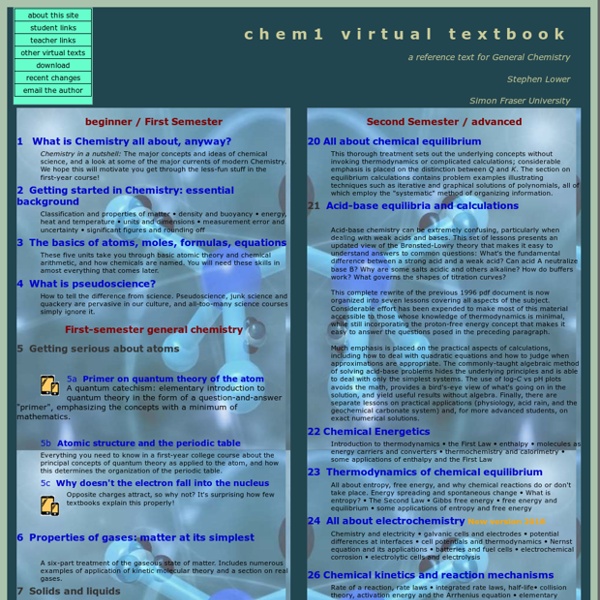Přehled minerálů a hornin | E-learning Katedry biologie PdF MU
Ve formě emulzních uzavřenin obsahuje Au, Ag, Bi, Ni a v malém množství někdy Co, tzv. danait. Jednoklonný (monoklinický, pseudorombický). Agregáty zrnité a celistvé, případně stébelnaté. Vytváří často kosočtverečné, dlouze nebo krátce sloupcovité krystaly, rýhované podle vertikály. Dvojčatí. Barva cínově bílá (rozdíl od pyritu), oxidací přechází do žluté. tvrdost: 5,5 - 6hustota: 5,9 - 6,3 g . cm-3 Animace krystalových soustav Výskyt Hlavní část přírodního arzenopyritu vznikla za vyšších teplot hydrotermální fáze. Význam Na některých lokalitách je zlatonosný, např. v polském Zlotém Stoku.
Chemistry Homework Help
Get help for your chemistry homework! You'll find a variety of resources, from ask-an-expert, online converters and calculators, study guides, dictionaries, a review of math/science fundamentals, and examples of worked problems. Chemistry AnswersStudents often ask "How do I get answers to chemistry questions online?" There are several ways to find answers and to ask chemistry questions and get them answered. Chemistry Help VideosLearn chemistry and reinforce your understanding of chemistry concepts by watching these chemistry videos. Best Chemistry Study TipsDid you take a chemistry class and have a really great way to study? How to Pass ChemistryAre you taking a chemistry class? Chemistry Study TipsHere are some homework and study tips to help you succeed in chemistry. How to Write a Lab ReportLab reports are an essential part of all laboratory courses and usually a significant part of your grade. Printable Chemistry WorksheetsThis is a collection of chemistry worksheets in pdf format.
Výukový portál | [CH] 2. st. - Chemie
Základní škola Kpt. Jaroše získala v rámci grantových projektů ESF 4 441 019,42,- Kč na realizaci dvou projektů.Školní a webové informační centrum Cílem projektu je umožnit žákům přístup k učivu, které bude zpracováno v elektronické podobě a zpřístupněno ve školním nebo webovém informačním centru. Předpokladem je, že služby centra budou moci využívat žáci školy v průběhu svého vzdělávání na základní škole i po jeho skončení. Vedle obsahu učiva budou zpracované materiály obsahovat testy, návrhy projektů, seminárních prací a odkazy na další doplňkovou literaturu. Součástí projektu bylo i vybudování školního informačního centra s počítači a interaktivní tabulí. Školní a webové informační centrum pro 1. stupeň základní školyCílem projektu je umožnit žákům 1. stupně přístup k učivu, které bude zpracováno v elektronické podobě a zpřístupněno ve školním nebo webovém informačním centru.
50 Awesome Chemistry Videos For The Busy Science Teacher
Though we don’t often recognize it, chemistry defines nearly every element of our everyday lives. From the reactions that fuel the sun to the biology of our bodies to the technology in our gadgets, chemistry is at the heart of everything we do and is the central science that unites biology, physics, geology, astronomy, medicine, and countless other fields. Yet chemistry doesn’t always get the credit and recognition it deserves for playing such an awesome role in, well, everything. If you’ve been slighting chemistry, there’s no better time to give the field the credit it deserves than National Chemistry Week. Founded in 1987, the week-long event has helped bring awareness to the role chemistry plays both in our lives today and in our future. Amazing Reactions and Experiments From incredible explosions to chameleon-like color changes, these experiments and demonstrations showcase some of the coolest reactions in chemistry. Lectures Courses Fun Miscellaneous
Biochemie - vzdělávací portál, Úvodní stránka



